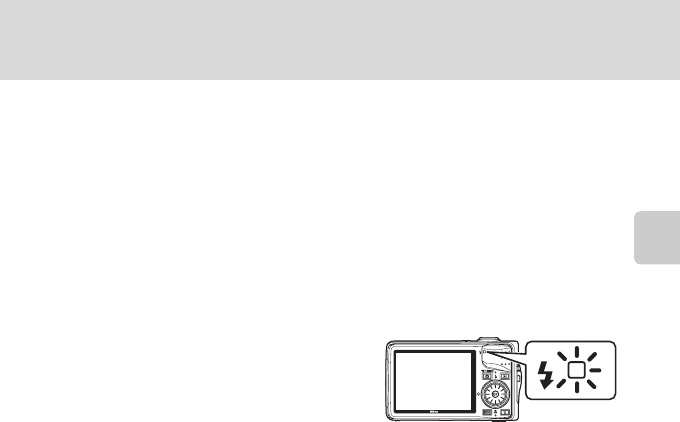
31
Using the Flash
Basic Photography and Playback : Auto Mode
B Shooting When Lighting is Poor and When the Flash is Disabled (W)
• Use of a tripod is recommended to stabilize the camera during shooting and avoid the effects of
camera shake. Set Vibration reduction (A131) to Off when using a tripod to stabilize the
camera during shooting.
• The E indicator is displayed when the camera automatically increases sensitivity. Pictures taken
when E is displayed may be slightly mottled.
• When E is displayed and higher sensitivity is applied, noise reduction may be automatically
applied as pictures are recorded. This will result in increased recording times.
B Note on Using the Flash
When using the flash, reflections from dust particles in the air may appear as bright spots in pictures.
To reduce these reflections, set the flash mode to W (Off).
C The Flash Lamp
The flash lamp indicates the flash status when the
shutter-release button is pressed halfway down.
• On : Flash will fire when picture is shot.
• Blinks :Flash is charging. Wait a few seconds and try
again.
• Off : Flash will not fire when picture is shot.
If the battery is low, the monitor display will turn off, and remain off, until the flash is fully charged.
C The Flash Mode Setting
The default flash mode setting varies with shooting mode.
• A (auto) mode: U (auto)
• Scene mode: setting varies for different scene modes (A36).
• d (sport continuous) mode: set to W (off)
• B (high sensitivity) mode: U (auto)
• a (smile) mode: set to W (off) (when Blink Proof is on),
U (auto) (when Blink Proof is off)
The flash mode setting applied in A (auto) mode or B (high sensitivity) mode is stored in the
camera’s memory even after the camera is turned off, and reapplied the next time A (auto) mode or
B (high sensitivity) mode is selected.
C Red-eye Reduction
This camera uses Advanced Red-eye Reduction (“In-Camera Red-Eye Fix”).
The flash fires repeatedly at low intensity before the main flash, reducing the red-eye effect.
The camera then analyzes the picture; if red-eye is detected, the affected area will be processed to
further reduce red-eye before the picture is saved.
Note that because there is a slight lag between the shutter-release button being pressed and the
picture being shot, this mode is not recommended when a quick shutter response is required. The
time before the next picture can be shot also increases slightly. Advanced red-eye reduction may not
produce the desired results in all situations. In extremely rare instances, areas not subject to red-eye
may be affected by advanced red-eye reduction processing; in these cases, choose another mode
and try again.


















